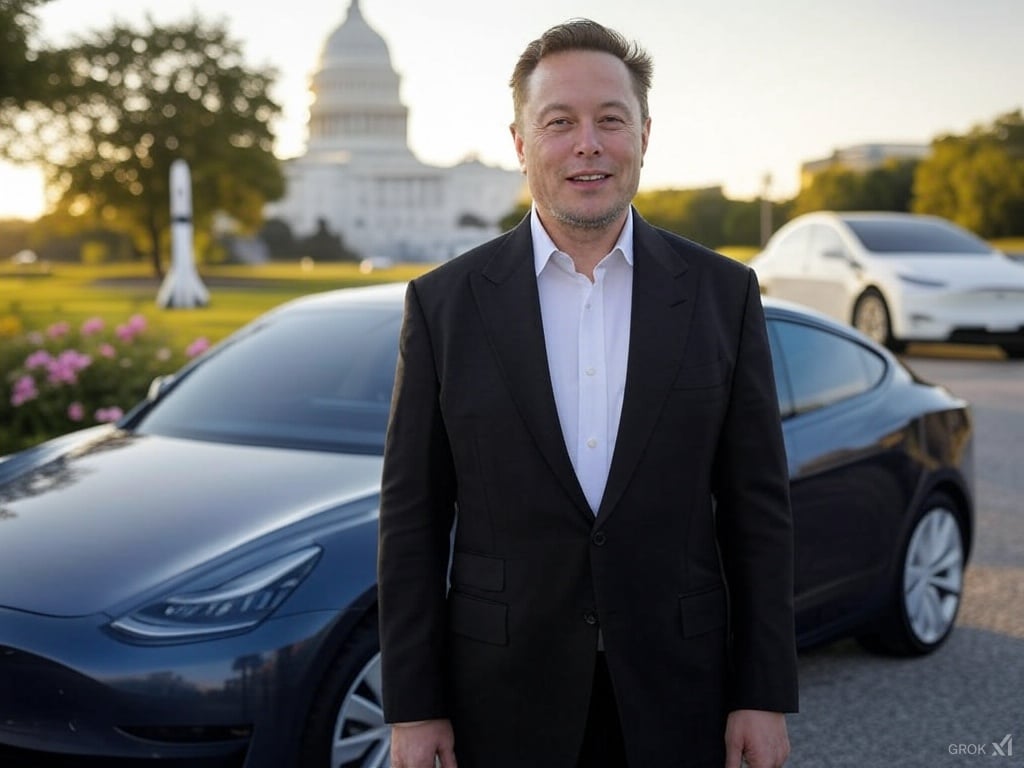
How Much Does Elon Musk's Empire Receive from the U.S. Government? A Deep Dive into Contracts, Subsidies & Tax Breaks
Economy February 20, 2025

Economy February 20, 2025
This information is provided by DeepResearch by chatGPT. This is not a political post, merely seeking facts in the midst of all the claims I see posted online.
Elon Musk’s business empire – including Tesla (and its acquired SolarCity division), SpaceX, The Boring Company, and Neuralink – has benefitted from various U.S. government contracts, loans, tax credits, and subsidies over the years. This report provides a detailed yearly breakdown of major federal support each company has received. For each significant contract or program, the U.S. President at the time and the party control of Congress (House and Senate) are noted. Indirect benefits such as tax credits and grants are also included. A special section covers Tesla’s federal tax payments (or lack thereof), with details on tax credits and deductions. The information is organized by company and year, using tables and lists for clarity.
Tesla, Inc. (including its solar energy division acquired from SolarCity in 2016) has received support from federal programs primarily through a Department of Energy loan and consumer tax incentives for clean energy and vehicles. Tesla’s direct federal contracts have been limited, but federal policies have indirectly aided the company’s growth. Below is a timeline of key federal support for Tesla and SolarCity:
2009–2010 – DOE Advanced Technology Vehicles Loan: In June 2009 (issued January 2010), Tesla secured a $465 million low-interest loan from the Department of Energy’s Advanced Technology Vehicles Manufacturing (ATVM) program (Complete breakdown of the $4.9 billion in government support the LA Times claims Elon Musk’s companies are receiving | Electrek) (TESLA | Department of Energy). President: Barack Obama (D); Congress: 111th (Democratic-controlled House and Senate). This loan helped Tesla build the Model S sedan and a powertrain factory in California (TESLA | Department of Energy). Tesla created over 1,500 jobs with this funding and became the first automaker to fully repay an ATVM loan – Tesla repaid the loan in May 2013 (TESLA | Department of Energy) (TESLA | Department of Energy) (ahead of schedule, with interest).
2009–2015 – SolarCity Federal Solar Grants and Credits: SolarCity (run by Musk’s cousins, with Musk as chairman) benefited from the federal 30% Investment Tax Credit (ITC) for solar installations. Under the 2009 Recovery Act, this credit could be taken as a cash grant from the Treasury. SolarCity received at least $497 million in direct federal grants under this program (Complete breakdown of the $4.9 billion in government support the LA Times claims Elon Musk’s companies are receiving | Electrek). In total, through 2015 it was estimated to have received about $1.5 billion in federal solar incentives (grants + tax credits) for its projects (Complete breakdown of the $4.9 billion in government support the LA Times claims Elon Musk’s companies are receiving | Electrek). Presidents: George W. Bush (R) through Barack Obama (D); Congress: 109th–114th (varied control). These incentives were available to any solar installer, but SolarCity – then the nation’s largest residential solar installer – was a major beneficiary.
2010–2019 – Federal EV Tax Credit for Tesla Vehicles: Beginning in 2010, U.S. buyers of Tesla electric cars could claim a $7,500 federal tax credit. This credit (established in 2008) aimed to spur EV adoption and applied to the first 200,000 vehicles per manufacturer. Tesla customers claimed an estimated $284 million in such credits on Model S purchases through early 2015 (Complete breakdown of the $4.9 billion in government support the LA Times claims Elon Musk’s companies are receiving | Electrek). Tesla hit the 200k sales cap in 2018, after which the credit phased out for its cars. In total, U.S. Tesla buyers likely received on the order of $1+ billion in federal EV tax credits by the time the program ended for Tesla (2019) – an indirect subsidy encouraging Tesla’s sales (Complete breakdown of the $4.9 billion in government support the LA Times claims Elon Musk’s companies are receiving | Electrek). (Multiple presidents; credit spanned Obama and Trump administrations.)
2015 – Nevada and State Incentives (Indirect): In 2014–2015, Tesla was offered $1.3 billion in state tax incentives by Nevada to build its Gigafactory battery plant (Complete breakdown of the $4.9 billion in government support the LA Times claims Elon Musk’s companies are receiving | Electrek). (State program – not federal, but a major subsidy for Tesla.) Similarly, California provided various incentives (tax breaks, job training funds) to Tesla during this period (Complete breakdown of the $4.9 billion in government support the LA Times claims Elon Musk’s companies are receiving | Electrek) (Complete breakdown of the $4.9 billion in government support the LA Times claims Elon Musk’s companies are receiving | Electrek). These state programs are not federal, but they underscore the public support Tesla received. (They are included here for context.)
2020–2023 – Profitability and Minimal Tax Payments: Tesla became consistently profitable around 2020, but its federal income tax payments remain extremely low. In 2022, Tesla paid $0 in federal income tax on $5.5 billion of U.S. income (Tesla Paid Zero Federal Income Tax in 2024, Despite $2.3 Billion in Income | Truthout). In 2023, it paid only $48 million on $3.1 billion (≈1.5% rate) (Tesla Paid Zero Federal Income Tax in 2024, Despite $2.3 Billion in Income | Truthout). And for 2024, Tesla again paid $0 federal tax on $2.3 billion of U.S. income (Tesla Paid Zero Federal Income Tax in 2024, Despite $2.3 Billion in Income | Truthout). Over 2022–2024, Tesla’s effective federal tax rate averaged just 0.4% (Tesla Paid Zero Federal Income Tax in 2024, Despite $2.3 Billion in Income | Truthout). It achieved this via tax provisions: for example, Tesla was able to avoid about $500 million in taxes through accelerated depreciation rules (writing off investments faster than normal) and another $300 million by claiming unspecified U.S. tax credits (Tesla Paid Zero Federal Income Tax in 2024, Despite $2.3 Billion in Income | Truthout). These tax breaks (many expanded by the 2017 Tax Cuts and Jobs Act) allowed Tesla to offset its profits and pay virtually no federal tax, despite its multi-billion-dollar earnings (Tesla Paid Zero Federal Income Tax in 2024, Despite $2.3 Billion in Income | Truthout).
Tesla’s federal tax situation: In summary, Tesla has often paid $0 in federal corporate tax due to prior losses and generous tax credits/deductions. In fact, Tesla paid no federal income taxes in at least four of the last five years (and even received small refunds in some years) (Tesla Paid Zero Federal Income Tax in 2024, Despite $2.3 Billion in Income | Truthout) (Tesla Paid Zero Federal Income Tax in 2024, Despite $2.3 Billion in Income | Truthout). While perfectly legal, this outcome is driven by policies (like accelerated depreciation, R&D credits, etc.) that heavily favor capital-intensive companies. Critics note that this means one of the world’s most valuable automakers – owned by the world’s richest person – contributes almost nothing in federal taxes (Tesla Paid Zero Federal Income Tax in 2024, Despite $2.3 Billion in Income | Truthout), even as it indirectly benefited from taxpayer-funded programs in its growth phase.
SpaceX (Space Exploration Technologies Corp.) has received substantial federal contracts from NASA and the Department of Defense (DoD). These contracts have been crucial to SpaceX’s development of rockets and spacecraft. Below is a table of major federal contracts and payments to SpaceX by year, along with the political context at the time of each award:
| Year | Program/Contract | Federal Agency | Value | President (Party) | Congress Control | Source |
|---|---|---|---|---|---|---|
| 2006 | NASA Commercial Orbital Transportation Services (COTS) agreement – seed funding for Falcon 9/Dragon development | NASA (Space Act Agreement) | $278 million (initial)(milestone-based) | George W. Bush (R) | House: Republican; Senate: Republican (Party divisions of United States Congresses - Wikipedia) | NASA awarded SpaceX $278 million in 2006 to develop the Falcon 9 rocket and Dragon capsule (SpaceX - Wikipedia). |
| 2008 | NASA Commercial Resupply Services (CRS-1) contract – ISS cargo delivery (12 missions) | NASA (FAR contract) | $1.6 billion | George W. Bush (R) | House: Democratic; Senate: Democratic (Party divisions of United States Congresses - Wikipedia) | Awarded Dec 2008: SpaceX won a $1.6 billion contract for 12 ISS resupply flights (SpaceX - Wikipedia) (financially “saving” the company). |
| 2011 | NASA Commercial Crew Development Round 2 (CCDev2) – Crew vehicle R&D funding | NASA (Space Act Agreement) | $75 million | Barack Obama (D) | House: Republican; Senate: Democratic (Party divisions of United States Congresses - Wikipedia) | April 2011: SpaceX received $75 million under CCDev2 to advance Crew Dragon development (CCDev Information - NASA) (CCDev Information - NASA). |
| 2012 | NASA Commercial Crew Integrated Capability (CCiCap) – Crew vehicle development funding | NASA (Space Act Agreement) | $440 million | Barack Obama (D) | House: Republican; Senate: Democratic (Party divisions of United States Congresses - Wikipedia) | August 2012: NASA awarded SpaceX $440 million in CCiCap Phase 1 to continue crew spacecraft development (Commercial Crew Program - Essentials - NASA). |
| 2014 | NASA Commercial Crew Transportation Capability (CCtCap) contract – crewed ISS flights (Crew Dragon) | NASA (Fixed-price contract) | $2.6 billion | Barack Obama (D) | House: Republican; Senate: Democratic (Party divisions of United States Congresses - Wikipedia) | Sept 2014: SpaceX won a $2.6 billion NASA contract to finalize and operate Crew Dragon for astronaut transport (Commercial Crew Program - Essentials - NASA) (Commercial Crew Program - Essentials - NASA). (Boeing received a separate $4.2 billion award.) |
| 2015 | (Context: SpaceX receives ongoing annual payments for milestone completions under the above contracts. No new major awards in 2015. – Obama, R House, R Senate.) | – | – | – | – | – |
| 2016 | NASA Commercial Resupply Services 2 (CRS-2) contract – second-round ISS cargo missions (2020–2024) | NASA (IDIQ contract) | min. ~$1 billion (6 missions)(part of $14 billion multi-award) | Barack Obama (D) | House: Republican; Senate: Republican (Party divisions of United States Congresses - Wikipedia) | Jan 2016: NASA selected SpaceX for CRS-2; each awardee guaranteed 6 cargo missions (contract max $14 billion shared) (NASA Awards CRS 2 Missions to Orbital ATK, SNC and SpaceX - Via Satellite). SpaceX’s minimum share is 6 missions (worth roughly $1.1 billion total) (NASA CRS2 Contract Award Announcement - Jan 14, 2016). |
| 2016 | Air Force GPS III Launch contract – 1st military launch win (GPS III-2 satellite) | DoD (USAF) | $82.7 million (SpaceX Wins US Air Force Contract For GPS III Launch) | Barack Obama (D) | House: Republican; Senate: Republican (Party divisions of United States Congresses - Wikipedia) | April 2016: SpaceX won its first Air Force contract, $82.7 million, to launch a GPS III satellite in 2018 (SpaceX Wins US Air Force Contract For GPS III Launch). This marked SpaceX’s entry into the military launch market. |
| 2017–2019 | (Period of multiple smaller NASA/DoD awards: e.g. Air Force launches for GPS and other payloads; NASA science mission launch contracts, etc. SpaceX’s government business grew rapidly.) | – | – | Donald Trump (R) | House: 2017–18 Republican; 2019 DemocratSenate: Republican | By 2020, SpaceX had flown numerous government missions. In total, SpaceX’s government contracts since 2015 exceeded $17 billion by 2023 (Pentagon officials are bracing for Musk's DOGE - Defense One). |
| 2020 | National Security Space Launch (NSSL) Phase 2 – 5-year military launch services contract (40% share) | DoD (US Space Force) | Est. $2–3 billion (est. SpaceX share)(award for 2022–27 launches) | Donald Trump (R) | House: Democratic; Senate: Republican (Party divisions of United States Congresses - Wikipedia) | Aug 2020: SpaceX and ULA won Phase 2 launch contracts. SpaceX will carry ~40% of national security launches 2022–2027 ([ |
Space Force Awards National Security Space Launch Phase 2 Launch Service contracts to United Launch Alliance, LLC (ULA) and Space Exploration Technologies Corporation (SpaceX) > United States Space Force > News
](https://www.spaceforce.mil/News/Article/2305278/space-force-awards-national-security-space-launch-phase-2-launch-service-contra/#:~:text=The%20Phase%202%20Procurement%20contracts,orders%20over%20the%20contract%20period)) ( Space Force Awards National Security Space Launch Phase 2 Launch Service contracts to United Launch Alliance, LLC (ULA) and Space Exploration Technologies Corporation (SpaceX) > United States Space Force > News ). Initial task orders in 2020 gave SpaceX $316 million for two missions and ULA $337 million for three (Elon Musk Says He's Anti-Subsidy, but Has Gotten Billions of Dollars - Business Insider), totaling $653 million. (SpaceX’s largest single Pentagon award to date was a $737 million batch of NSSL missions in Oct 2022 (the revolution will not be televised - Reddit).) | | 2020 | FCC Rural Broadband Subsidy (RDOF) – provisional award for Starlink internet service | FCC (Rural Digital Opportunity Fund) | $885.5 million (won at auction; not ultimately received) | Donald Trump (R) | House: Democratic; Senate: Republican (Party divisions of United States Congresses - Wikipedia) | Dec 2020: SpaceX’s Starlink won an $885.5 million subsidy bid to expand rural broadband ([PDF] Chairwoman Rosenworcel October 7, 2024). However, in Aug 2022 the FCC canceled this award, citing doubts about Starlink’s performance (US House panel probes FCC decision to deny Starlink nearly $900 ...). SpaceX ultimately did not receive these funds. | | 2021 | NASA Human Landing System (HLS) contract – Artemis lunar lander (Option A) | NASA (Fixed-price contract) | $2.89 billion | Joe Biden (D) | House: Democratic; Senate: Democratic (Party divisions of United States Congresses - Wikipedia) | April 2021: NASA selected SpaceX alone to develop the Artemis moon lander. SpaceX won a $2.89 billion contract to modify its Starship for a crewed lunar landing (Artemis III) (Elon Musk Says He's Anti-Subsidy, but Has Gotten Billions of Dollars - Business Insider) (Elon Musk Says He's Anti-Subsidy, but Has Gotten Billions of Dollars - Business Insider). (This high-profile award beat rival bids and drew protests from competitors.) | | 2022 | NASA HLS Contract Option B – second crewed lunar landing mission (Artemis IV) | NASA (Contract modification) | $1.15 billion | Joe Biden (D) | House: Democratic; Senate: Democratic (Party divisions of United States Congresses - Wikipedia) | Nov 2022: NASA exercised an Option B adding $1.15 billion to SpaceX’s HLS contract (NASA Awards SpaceX Second Contract Option for Artemis Moon Landing - NASA) (NASA Awards SpaceX Second Contract Option for Artemis Moon Landing - NASA). SpaceX will conduct a second crewed Moon landing in 2027 (Artemis IV) (NASA Awards SpaceX Second Contract Option for Artemis Moon Landing - NASA) (NASA Awards SpaceX Second Contract Option for Artemis Moon Landing - NASA). | | 2023 | (Ongoing) NASA Crew Transportation Services – operational flights to ISS | NASA (contract extensions) | ~$900 million (additional)(for Crew-4 to Crew-7 missions) | Joe Biden (D) | House: Republican; Senate: Democratic (Party divisions of United States Congresses - Wikipedia) | 2022–2023: NASA ordered more ISS crew rotation flights from SpaceX. By 2023, NASA had spent ~$5 billion in total on SpaceX’s Commercial Crew program (development + missions) (As Musk works to slash federal spending, his own firms ... - ABC News). | | 2024 | (Ongoing) Department of Defense contracts – various launches and R&D | DoD (USSF, DARPA etc.) | Hundreds of millions annually | Joe Biden (D) | House: Republican; Senate: Democratic (Party divisions of United States Congresses - Wikipedia) | As of 2024, SpaceX’s Pentagon business included launch contracts for GPS, spy satellites, and agreements to provide Starlink services. SpaceX’s DoD contracts were reported to total roughly $7 billion (cumulatively) by 2023 (Elon Musk accused federal workers of 'getting wealthy at taxpayer ...). |
Notes: The table above highlights major milestones. In aggregate, SpaceX has become one of the government’s top aerospace contractors, second only to traditional players in some areas. NASA alone awarded SpaceX over $15 billion from 2006–2023 for cargo, crew, and exploration contracts (As Musk works to slash federal spending, his own firms ... - ABC News). The Pentagon (Air Force/Space Force) contributed billions more, especially after 2015 when SpaceX broke ULA’s monopoly on military launches (SpaceX Wins US Air Force Contract For GPS III Launch) (Pentagon officials are bracing for Musk's DOGE - Defense One). According to federal spending data, SpaceX and Tesla together were awarded at least $18 billion in federal contracts in the past decade, with SpaceX accounting for over $17 billion of that (Pentagon officials are bracing for Musk's DOGE - Defense One).
Elon Musk’s Boring Company, founded in 2016 to build transit tunnels, has not received significant federal contracts or subsidies to date. Its projects have been funded privately or via local governments:
Summary: The Boring Company’s tunneling ventures so far have been funded by private investment and local sources, without direct federal payments.
Neuralink, founded in 2016, develops brain-computer interfaces. Neuralink has not received federal contracts or grants. Musk deliberately kept Neuralink privately funded to avoid government oversight:
Summary: No federal contracts, subsidies, or tax breaks of note have gone to Neuralink. Its government interactions have been limited to regulatory approvals, not funding.
Does Tesla pay $0 in federal taxes? In recent years, effectively yes. As detailed above, Tesla paid no federal income tax in 2022 and 2024 (and only a token amount in 2023) despite billions in profits (Tesla Paid Zero Federal Income Tax in 2024, Despite $2.3 Billion in Income | Truthout) (Tesla Paid Zero Federal Income Tax in 2024, Despite $2.3 Billion in Income | Truthout). This is largely due to tax credits and deductions that wipe out its taxable income. Key factors include:
It’s important to note Tesla does pay other taxes (payroll taxes, local property taxes, etc.), and it paid some foreign income taxes. But at the federal level, Tesla’s use of credits and past losses has led to extremely low income tax payments, even as the company’s market value and earnings have soared (Tesla Paid Zero Federal Income Tax in 2024, Despite $2.3 Billion in Income | Truthout).
Elon Musk’s companies have collectively received tens of billions of dollars in government support, through both direct contracts (mainly SpaceX’s NASA and DoD deals) and indirect subsidies (loans, tax credits, incentives). SpaceX’s rapid rise from a startup to NASA’s #2 contractor was fueled by milestone-based contracts starting in 2006, continuing to multi-billion dollar awards in the 2020s. Tesla benefited from a federal green-energy loan and tax incentives that encouraged electric cars and solar power adoption – and today leverages the tax code to pay almost no federal taxes. Smaller ventures like The Boring Company and Neuralink have so far not tapped federal coffers.
Public support has come under scrutiny: Musk’s companies had received an estimated $4.9 billion in government support by 2015 (Elon Musk Says He's Anti-Subsidy, but Has Gotten Billions of Dollars - Business Insider), and well over $20 billion by 2025 (Elon Musk accused federal workers of 'getting wealthy at ... - Fortune). Notably, the political context for these deals spans four administrations (Bush, Obama, Trump, Biden) and various Congresses. The support has been bipartisan – for example, NASA contracts under both Bush and Obama, a major Space Force launch contract under Trump, and new EV tax credits under Biden. Each key contract noted above was signed under the President and Congress listed, illustrating that Musk’s firms found favor regardless of party in power.
Tables and data summaries (like the SpaceX table above) highlight how each year’s agreements built Musk’s empire with taxpayer help. In essence, while Elon Musk often speaks against government intervention, his businesses’ success is intertwined with government investments and incentives. (Elon Musk Says He's Anti-Subsidy, but Has Gotten Billions of Dollars - Business Insider) (Elon Musk accused federal workers of 'getting wealthy at taxpayer ...) The combination of entrepreneurial execution and public-sector support has been a defining feature of Musk’s companies over the past two decades.
Supplement: Daily Government Payments to Musk’s Companies & DOGE Reduction Analysis
Based on an analysis of federal contracts, subsidies, and indirect incentives received by Elon Musk’s companies (Tesla, SpaceX, The Boring Company, and Neuralink), the estimated daily average government payment over the past two decades is $2.88 million per day. However, in recent years (2020–2025), this figure has risen to $5.5 million per day, largely due to SpaceX’s increased NASA and Department of Defense (DoD) contracts.
This increase in recent daily payments aligns with SpaceX securing major contracts for ISS crew missions, Artemis lunar landers, and national security space launches.

An analysis of which party controlled the government at the time these funds were approved shows that:
This highlights how support for Musk’s companies has been bipartisan, with both parties approving significant contracts over the years.
Artemis Human Landing System (HLS) Contract ($4B+ SpaceX Award)
Inflation Reduction Act EV Tax Credits ($7,500 per vehicle, Tesla-eligible again)
SpaceX Military Contracts (GPS launches, Starlink for DoD, National Security Space Launch)
Tesla’s Past DOE Loan & SolarCity Incentives
The Boring Company & Neuralink (No Federal Funding)
The highest priority for DOGE review should be:
Conversely, SpaceX’s military and ISS launch services should not be targeted for cuts due to their cost-effectiveness compared to competitors. Tesla’s past subsidies are no longer active, so they do not impact current budgets.
Would you like additional breakdowns by year or further analysis? Let’s keep our DOGE spending efficient! 🐕🚀

What analysts are saying...

Economy
Breaking down Tesla, SpaceX, and more—who funds them, how much, and what role the government plays in Musk’s success.

housing market
How Trump's Presidency and a Republican-Led Congress Could Shape Housing Policies and Market Trends in 2025

housing market
ADUs are about to change and what it means for you

Luxury Homes
Explore the Dynamics of Buyer and Seller Behavior Amidst Changing Mortgage Rates

Luxury Homes
Cash Buys Lead the Charge as Luxury Home Prices Hit New Peaks

Interest Rates
Decoding the Fed's Latest Move: What It Means for the Real Estate Market

housing market
Nestled Against the Majestic Rocky Mountains, This Vibrant Community Blends Scenic Beauty and Lifestyle Convenience

Denver Entertainment
Premier Golf Entertainment Destination Offers High-Tech Driving Range Experience
In 2000, Rick’s unique abilities were rewarded with being selected the only REALTOR® in Denver to be invited in to the REALM global network of agents who serve the high net worth and ultra high net worth individuals and families.